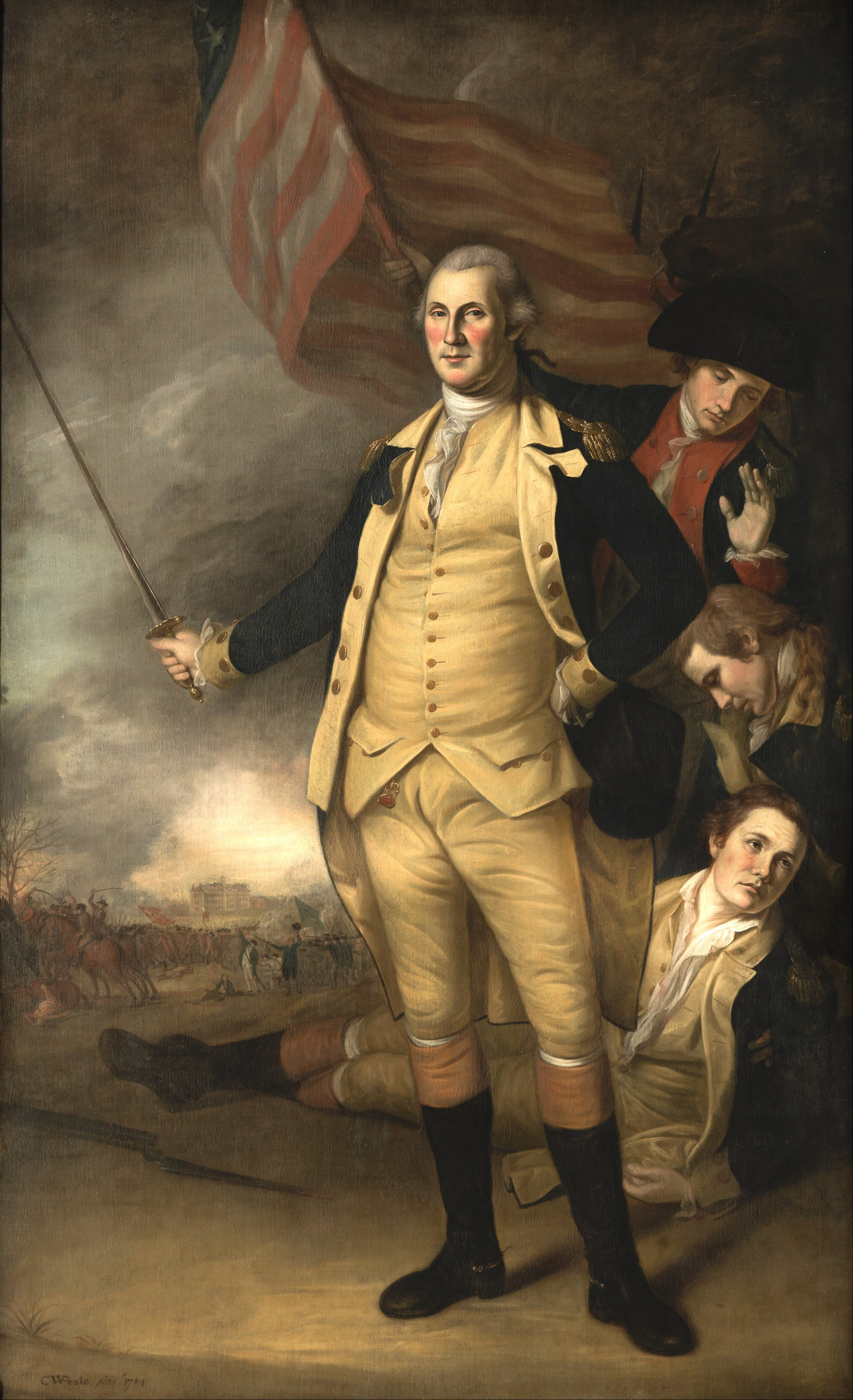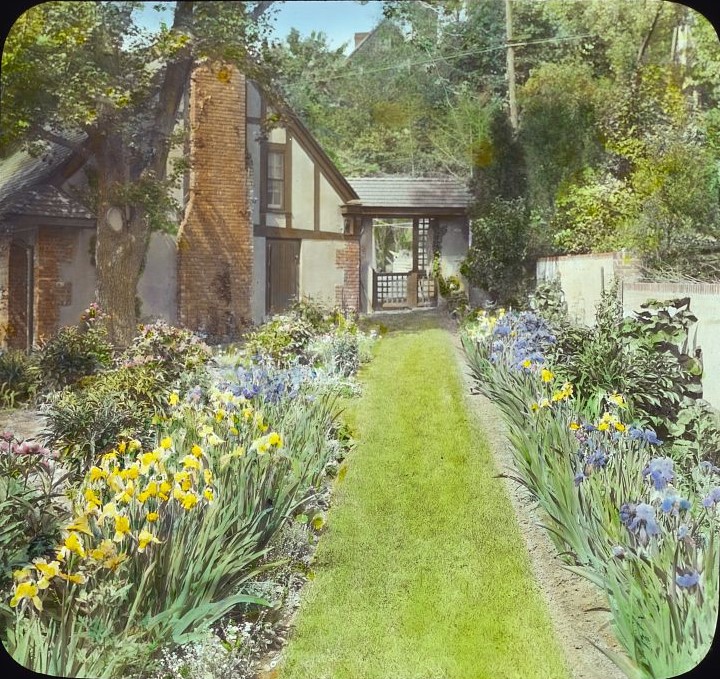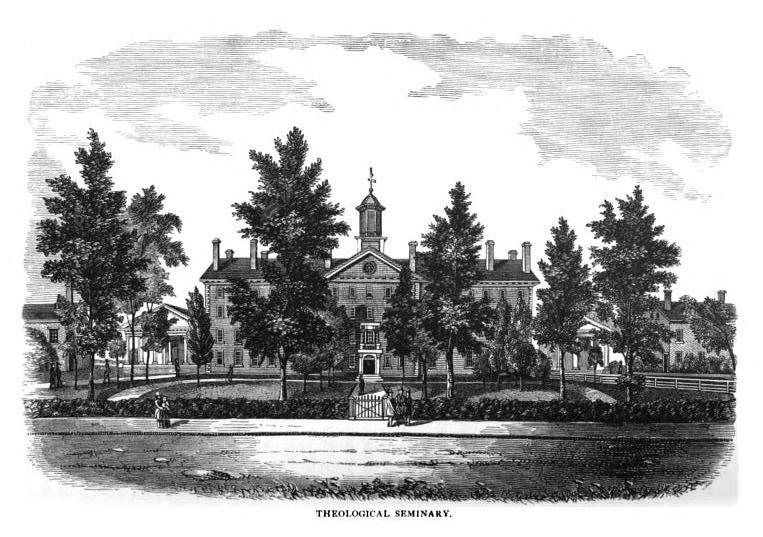|
Nassau Club
The Nassau Club of Princeton, New Jersey, founded in 1889 by, among others, Woodrow Wilson as a town-and-gown club to bring the townspeople and the University faculty together, is now a private social club. It moved into its current location in 1903. The clubhouse was originally built in 1813-14 as the home of Samuel Miller, the second professor of the Princeton Theological Seminary, on land belonging to his father-in-law, Continental Congressman Jonathan Dickinson Sergeant. Sergeant had built a large house on the site shortly before the American Revolution but it was burned down during the British occupation prior to the Battle of Princeton. The club provides dining and social spaces, as well as guest rooms for visiting members. Originally formed as a men's club, it has allowed both male and female members for several decades. The clubhouse was expanded in 1911, by architect Aymar Embury II, and in 1969 a banquet dining room was added, with extensive renovations in 1992. ... [...More Info...] [...Related Items...] OR: [Wikipedia] [Google] [Baidu] |
Woodrow Wilson
Thomas Woodrow Wilson (December 28, 1856February 3, 1924) was an American politician and academic who served as the 28th president of the United States from 1913 to 1921. A member of the Democratic Party, Wilson served as the president of Princeton University and as the governor of New Jersey before winning the 1912 presidential election. As president, Wilson changed the nation's economic policies and led the United States into World War I in 1917. He was the leading architect of the League of Nations, and his progressive stance on foreign policy came to be known as Wilsonianism. Wilson grew up in the American South, mainly in Augusta, Georgia, during the Civil War and Reconstruction. After earning a Ph.D. in political science from Johns Hopkins University, Wilson taught at various colleges before becoming the president of Princeton University and a spokesman for progressivism in higher education. As governor of New Jersey from 1911 to 1913, Wilson broke with party b ... [...More Info...] [...Related Items...] OR: [Wikipedia] [Google] [Baidu] |
Private Club
A club is an association of people united by a common interest or goal. A service club, for example, exists for voluntary or charitable activities. There are clubs devoted to hobbies and sports, social activities clubs, political and religious clubs, and so forth. History Historically, clubs occurred in all ancient states of which exists detailed knowledge. Once people started living together in larger groups, there was need for people with a common interest to be able to associate despite having no ties of kinship. Organizations of the sort have existed for many years, as evidenced by Ancient Greek clubs and associations (''collegia'') in Ancient Rome. Origins of the word and concept It is uncertain whether the use of the word "club" originated in its meaning of a knot of people, or from the fact that the members "clubbed" together to pay the expenses of their gatherings. The oldest English clubs were merely informal periodic gatherings of friends for the purpose of dinin ... [...More Info...] [...Related Items...] OR: [Wikipedia] [Google] [Baidu] |
Princeton Historic District (Princeton, New Jersey)
The Princeton Historic District is a historic district located in Princeton, New Jersey that was listed on the U.S. National Register of Historic Places in 1975. It stretches from Marquand Park in the west to the Eating Clubs in the East, from the Princeton Cemetery in the north to the Graduate College in the south. The district encompasses the core parts of the campuses of the Princeton Theological Seminary and Princeton University. It also includes the business district centered on Nassau Street and many historic homes, both mansions in the western section and more humble dwellings in the Witherspoon/Jackson neighborhood. Notable churches within the district include Nassau Presbyterian Church, Trinity Episcopal, Nassau Christian Center, and the Princeton University Chapel. The district is home to seven of Princeton's nine, and New Jersey's fifty-eight, National Historic Landmarks, the largest concentration of such sites in the state. Significance Princeton, and the ... [...More Info...] [...Related Items...] OR: [Wikipedia] [Google] [Baidu] |
Princeton, New Jersey
Princeton is a municipality with a borough form of government in Mercer County, in the U.S. state of New Jersey. It was established on January 1, 2013, through the consolidation of the Borough of Princeton and Princeton Township, both of which are now defunct. Centrally located within the Raritan Valley region, Princeton is a regional commercial hub for the Central New Jersey region and a commuter town in the New York metropolitan area.New York-Newark, NY-NJ-CT-PA Combined Statistical Area . Accessed December 5, 2020. As of the |
Aymar Embury II
Aymar Embury II (June 15, 1880 – November 15, 1966) was an American architect. He is best known for commissions from the City of New York from the 1930s through to the 1950s. In this period, Embury frequently worked with Robert Moses in the latter's various city and state capacities, especially, early on, in Moses’ capacity as New York City Parks Commissioner. Many surviving examples of Embury's work are zoos, swimming pools, playgrounds, and other recreational structures in New York City parks. Biography Embury was born in New York City to Aymar Embury and Fannie Miller Bates. Married four times, his first union was with Dorothy Coe in 1904. They later divorced, and he married Ruth Dean. Dean was a famous landscape designer who designed Grey Gardens during the marriage. The two worked out of the same office but had separate shingles for their businesses. A widower in 1932, he married Josephine Bound in 1934, which ended in divorce. He was survived by his fourth w ... [...More Info...] [...Related Items...] OR: [Wikipedia] [Google] [Baidu] |
Samuel Miller (theologian)
Samuel Miller (October 31, 1769 – January 7, 1850) was a Presbyterian theologian who taught at Princeton Theological Seminary. Biography Samuel Miller was born in Dover, Delaware, on October 31, 1769. His father was the Rev. John Miller (1722–1791). Miller attended the University of Pennsylvania and graduated in 1789. He earned his license to preach in 1791, and the University of Pennsylvania awarded him a Doctorate of Divinity degree (D.D.) in 1804. From 1813 to 1849, he served as Professor of Ecclesiastical History and Church Government at Princeton Theological Seminary, and was also integral in founding the institution. Throughout his life, Miller was a vigorous participant in many of the controversies that took place within the Presbyterian Church, including that which resulted in the division of the church into new and old schools. He was also considered an authority on many of the issues that faced Christians, especially Presbyterians, of his time. Miller is, p ... [...More Info...] [...Related Items...] OR: [Wikipedia] [Google] [Baidu] |
Princeton Theological Seminary
Princeton Theological Seminary (PTSem), officially The Theological Seminary of the Presbyterian Church, is a private school of theology in Princeton, New Jersey. Founded in 1812 under the auspices of Archibald Alexander, the General Assembly of the Presbyterian Church (USA), and the College of New Jersey (now Princeton University), it is the second-oldest seminary in the United States. It is also the largest of ten seminaries associated with the Presbyterian Church. Princeton Seminary has long been influential in theological studies, with many leading biblical scholars, theologians, and clergy among its faculty and alumni. In addition, it operates one of the largest theological libraries in the world and maintains a number of special collections, including the Karl Barth Research Collection in the Center for Barth Studies. The seminary also manages an endowment of $1.13 billion, making it the third-wealthiest institution of higher learning in the state of New Jersey—after ... [...More Info...] [...Related Items...] OR: [Wikipedia] [Google] [Baidu] |
Second Continental Congress
The Second Continental Congress was a late-18th-century meeting of delegates from the Thirteen Colonies that united in support of the American Revolutionary War. The Congress was creating a new country it first named "United Colonies" and in 1776 renamed "United States of America." It convened in Philadelphia on May 10, 1775, with representatives from 12 of the colonies. This came shortly after the Battles of Lexington and Concord and was in succession to the First Continental Congress which met from September 5 to October 26, 1774. The Second Congress functioned as a ''de facto'' national government at the outset of the Revolutionary War by raising armies, directing strategy, appointing diplomats, and writing petitions such as the Declaration of the Causes and Necessity of Taking Up Arms and the Olive Branch Petition. All thirteen colonies were represented by the time the Congress adopted the Lee Resolution which declared independence from Britain on July 2, 1776, and the ... [...More Info...] [...Related Items...] OR: [Wikipedia] [Google] [Baidu] |
Jonathan Dickinson Sergeant
Jonathan Dickinson Sergeant (1746 – October 8, 1793) was an American lawyer from Princeton, New Jersey. He represented New Jersey in the Second Continental Congress in 1776 and 1777. He later served as Attorney General for the state of Pennsylvania. Life and career Sergeant was born in 1746 in Newark, New Jersey, the son of Abigail (Dickinson) and Jonathan Sergeant. He moved with his parents to Princeton. He completed his initial studies and attended the College of New Jersey (now Princeton University), receiving his degree in 1762. His maternal grandfather, Jonathan Dickinson, had been the first president of the college at its founding in 1747. After Sergeant's graduation from the College of Philadelphia (now the University of Pennsylvania) in 1763 with an A.B. degree, he read for the law and entered practice in Princeton in 1767. From 1774 to 1776 he was a member of the revolutionary New Jersey Provincial Congress. In early 1776 he went as a delegate to the Continental Congres ... [...More Info...] [...Related Items...] OR: [Wikipedia] [Google] [Baidu] |
American Revolution
The American Revolution was an ideological and political revolution that occurred in British America between 1765 and 1791. The Americans in the Thirteen Colonies formed independent states that defeated the British in the American Revolutionary War (1775–1783), gaining independence from the The Crown, British Crown and establishing the United States of America as the first nation-state founded on Age of Enlightenment, Enlightenment principles of liberal democracy. Colonial history of the United States, American colonists objected to being taxed by the Parliament of Great Britain, a body in which they had no taxation without representation, no direct representation. Before the 1760s, Britain's American colonies had enjoyed a high level of autonomy in their internal affairs, which were locally governed by colonial legislatures. During the 1760s, however, the British Parliament passed a number of acts that were intended to bring the American colonies under more direct rule f ... [...More Info...] [...Related Items...] OR: [Wikipedia] [Google] [Baidu] |
Battle Of Princeton
The Battle of Princeton was a battle of the American Revolutionary War, fought near Princeton, New Jersey on January 3, 1777, and ending in a small victory for the Colonials. General Lord Cornwallis had left 1,400 British troops under the command of Lieutenant Colonel Charles Mawhood in Princeton. Following a surprise attack at Trenton early in the morning of December 26, 1776, General George Washington of the Continental Army decided to attack the British in New Jersey before entering the winter quarters. On December 30, he crossed the Delaware River back into New Jersey. His troops followed on January 3, 1777. Washington advanced to Princeton by a back road, where he pushed back a smaller British force but had to retreat before Cornwallis arrived with reinforcements. The battles of Trenton and Princeton were a boost to the morale of the patriot cause, leading many recruits to join the Continental Army in the spring. After defeating the Hessians at the Battle of Trenton on ... [...More Info...] [...Related Items...] OR: [Wikipedia] [Google] [Baidu] |
Sons And Fascination/Sister Feelings Call
''Sons and Fascination/Sister Feelings Call'' is the (double-LP) fourth album by Scottish post-punk band Simple Minds. It was released in September 1981 and was their first to reach a wide international audience. It includes the singles " The American", "Love Song" and "Sweat in Bullet". Overview ''Sons and Fascination'' and ''Sister Feelings Call'' were two separate albums. They were assembled from the same sessions and released at the same time and, in some instances, sold as a double-LP set. The two releases are variously categorised as a double album, two single albums or a single album and an extended play. The current CD remaster contains all the tracks once split onto two LPs, with their respective track running orders preserved. The original 1985 CD reissue deleted two songs from ''Sister Feelings Call'', "League of Nations" and "Sound in 70 Cities", as the maximum running time of Red Book CD releases at the time would not accommodate the entire set, and Virgin were unwil ... [...More Info...] [...Related Items...] OR: [Wikipedia] [Google] [Baidu] |







